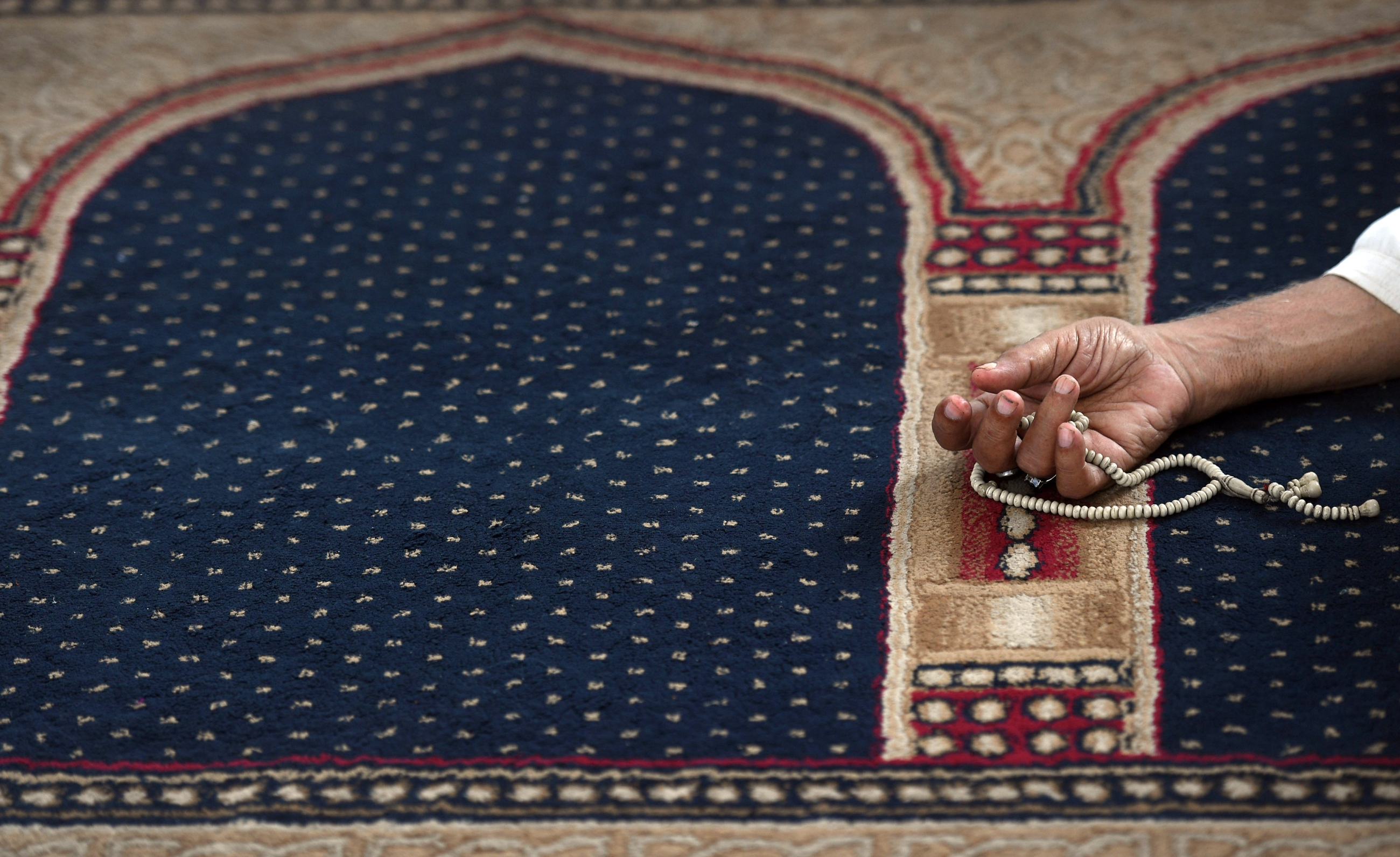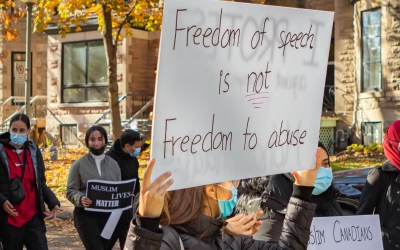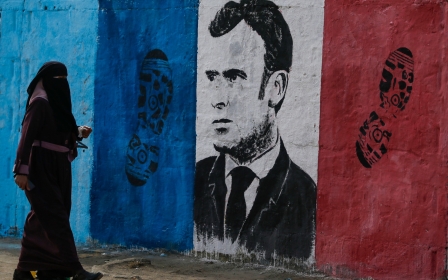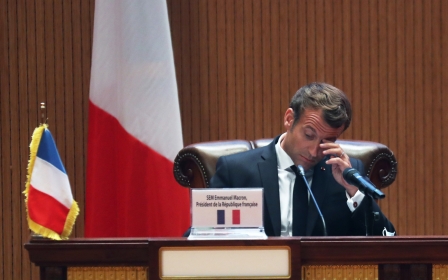Olivier Roy: France's government fails to understand the nature of radicalisation

His arguments may go unheard among top government circles, but Olivier Roy, a French political scientist and professor at the European University Institute in Florence, Italy, is a prominent figure in the French intellectual world. His work sheds light on the mechanisms and complexities of radicalisation processes.
In 2015, he coined the phrase the "Islamicisation of radicalism" as opposed to the "radicalisation of Islam", a theory put forward by another leading scholar of Islam, Gilles Kepel, who in a 2018 column accused Roy of being a "jihad de-negationist".
The insults and name-calling are highly symptomatic of the underlying political significance of what had started off as a purely academic quarrel.
Middle East Eye spoke with the academic about his analysis of Islam and questions of radicalisation, which he says is a whole comprised of many components, of which Islam is but one among many others. That is a view that warrants a closer look, as French authorities struggle to effectively blunt the threat of radicalism.
Middle East Eye: In the wake of the November 2015 Paris attacks, you qualified the radicalisation of French Muslim youths who went to Syria to fight alongside armed Islamist groups as a sign of the "Islamicisation of radicalism". The scholar of radical Islam, Gilles Kepel, takes the opposite view, calling it rather the "radicalisation of Islam". After the murder on 16 October of Samuel Paty and the stabbings in Nice on 29 October, do you still have the same dissenting view of radical Islam?
Olivier Roy: Yes, of course. My standpoint is simply more nuanced than that of Gilles Kepel, who sees things in terms of overarching dualisms, in either black or white. His analysis is rooted in a widely held belief that French society is being Islamicised, and that the rise of terrorism can be explained by Islamist movements in France.
MEE: Are these recent attacks in any way related to the Charlie Hebdo and Hypercacher supermarket attacks of January 2015, and to the November 2015 Bataclan attacks, despite their having different modus operandi [MO]?
OR: There are common threads to all of these terrorist narratives, but ruptures with earlier patterns can also be seen. I talk about this idea of continuity in my book Jihad and Death. Since 1995, the perpetrators of terrorist attacks in France have regularly chosen death. For the most part, they are suicide attacks, unlike those committed in the 1970s and 1980s [including the 3 October 1980 synagogue bombing in Paris, the 9 August 1982 Jewish restaurant bombing in the Marais district, attributed to the Lebanese Hezbollah].
'These radicals have not gone from French-bred Salafism to terrorism. […] Radicalised youths do not socialise at the mosque'
And yet suicide attacks, whether for al-Qaeda or the Islamic State, are irrational from a military standpoint. During the First Intifada in Palestine in the 1980s, terrorist groups had carefully laid out back-up plans to escape and try again if something went wrong. This is the ABC of political terrorism. And yet in the past 25 years, our homegrown terrorists have systematically chosen to die. This I believe is one of the keys to understanding radicalisation today.
Then, there is the fact that suicide attacks kill indiscriminately. They play on our fears and have no strategic impact. They are directed not at the Israeli consulate but at a synagogue. They target the public at large.
Furthermore, they are carried out in the name of a specific jihad: Khaled Kelkal in Lyon was affiliated to the Algerian GIA [Armed Islamist Group], "the Roubaix gang" terrorist cell was part of the Bosnian mujahideen, and the Bataclan attacks were claimed by the Islamic State (IS).
Another common narrative thread is the view that blasphemy in Islam is punishable by death. This was the motive behind al-Qaeda's calls against Charlie Hebdo in 2005, after the satirical newspaper published the cartoons [of the Prophet Muhammad]. It was also that of the earlier fatwa against Salmon Rushdie (author of The Satanic Verses).
On the other hand, certain elements break with these earlier MOs. For example, up until 2015, attacks were being carried out by armed groups, some large, some small, as in the case of the Bataclan. The cells were backed by networks of individuals with ties to al-Qaeda and IS, who had either been to training camps abroad or were in contact with the organisations.
In some cases in France, the terrorists were radicalised by former jihadists, members of al-Qaeda or IS, like Djamel Beghal (active in the Algerian GIA). These new cells are connected to the older groups, thus forming a network.
Another point I would like to make perfectly clear - and here too I am in complete disagreement with Gilles Kepel - is that these radicals have not gone from French-bred Salafism to terrorism. In the first place, neighbourhoods are not converted to Salafism simply because there is a mosque or an imam. Radicalised youths do not socialise at the mosque.
The only exception, documented by Hugo Micheron in his book French Jihadism, Neighbourhoods, Syria, Prison, is the Artigat cell near Toulouse. It's a totally uncharacteristic case, on a farm in the country, with no connection whatsoever to the projects, or to the troubled suburbs.
MEE: So, you draw no correlation whatsoever between embracing religion and terrorism?
OR: What I'm basically saying is that it is not a question of first embracing Salafism and then moving on to terrorism. This is why I talk about the Islamisation of radicalism. The break with society comes first, possibly followed by an immersion in Salafism but, in many cases, radicalisation is not preceded by a Salafist phase at all.
The recent attacks are an example of this. However, these young people who resort to violent action see Islam as an inviolate framework - the martyr will pass through the gates of heaven.
MEE: Why were the 2015 attacks a turning point in terms of attackers' profiles?
OR: In the first place, the perpetrators of terrorism after 2015 have no ties to IS whatsoever. Some sort of ideological allegiance may of course exist, but no concrete connections. In other words, post-2015 terrorists are acting without the permission of a higher authority. They have not trained abroad and are not even remotely connected to an organisation's "administration".
'The break with society comes first, possibly followed by an immersion in Salafism but, in many cases, radicalisation is not preceded by a Salafist phase'
Secondly, they are acting almost completely on their own. This doesn't mean they don't have friends: they may have talked about their intentions. They may have tweeted or posted messages on Facebook. But they are not part of a group or a network. They do not have any logistical support.
The suspects in the Charlie Hebdo attacks [currently on trial in Paris] are accused of having provided logistical support to the perpetrators - the brothers Said and Cherif Kouachi, and their accomplice, Amedy Coulibaly. The hearing will determine whether the people who provided logistical support were aware of the perpetrators' intent to commit murder. This, however, is another matter.
In the recent attacks in France, the move to action came very suddenly, with no prior immersion in either Salafism or jihadism. The assailants were radicalised individually, in a fairly short amount of time.
Another thing these recent attacks have in common - knives. Bladed weapons have been used in every single attack committed in France since 2016.
MEE: Why knives? Is it a symbolic choice?
OR: For one thing, it shows these recent assailants have no connections to weapons networks. It means they are improvising.
But I think there's more to it than that. Today, a Kalashnikov can be purchased in Marseille for a mere few hundred euros. I doubt they even tried.
These assailants are not trying to kill as many people as possible. They are interested in sacrifice, in ritual slaughter. You kill people with a knife and are then killed in turn, bloody weapon in hand. It's a suicide committed in the name of the Prophet, with hopes of going to heaven. The assailants are assuming the role of high priest, they are dispensing religious justice.
MEE: We have seen how the video posted by Brahim Chnina, the father of one of Samuel Paty's students who complained about Paty for showing the cartoons, played a part in the horrific killing by Abdullakh Anzorov. Knife attacks like these appear to be orchestrated with social media in mind. The live broadcast of the Christchurch attacks come to mind. Anzorov was a "digital native". A statement written at 12:17pm was posted on Twitter at 4:55pm. His actions were symbolic, but would you say he was also trying to garner media coverage?
OR: Yes, I definitely would. Staging here is very important and entirely in keeping with the slasher aesthetic that IS has instrumentalised from the very start, by means of videos circulating on social media, for example.
'These youths are completely immersed in today's globalised culture of individualism, in line with a neoliberal ideology, contending, in a word, that anybody can become rich and famous'
The communication of IS is geared to today's youth culture. It spins the narrative of the avenging hero getting payback for past humiliations, his own and those of the Muslim world, by offering up a sacrificial victim. Staging is very important.
Interestingly enough, however, the first murderous fantasies posted on the internet were the brainchild not of Islamist extremists but of the teenage perpetrators of the Columbine High School shootings in 1999. And the fact that the two youths made home videos prior to the attack making references to what they were going to do is fundamental. It is indicative of a certain youth culture that has been developing over the past 20 years.
MEE: A "digital native" generation brought up on social media platforms lambasted for their lack of regulations. Could profiles like these be the manifestation of the darker side of capitalism?
OR: Yes. Youths today are completely immersed in a globalised culture of individualism, in keeping with a neoliberal ideology, contending, in a word, that anybody can become rich and famous.
Socioeconomic condition doesn't matter when you only need a garage and a DIY computer to be the next Bill Gates. An idea capable of switching egos into overdrive… "Everybody thinks I'm a loser, but I’m going to do something big."
Of course, the terrorists we are talking about are the opposite of Bill Gates. They are negative heroes.
So yes, I'd say there's this idea that it's all about communication, that we could go from anonymity to stardom, and this definitely ties in with social media policies and - by association - neoliberal constructs. You find this idea among the Brazilian and Nigerian evangelists, for that matter, who preach the prosperity gospel: I am a poor man but if I have faith in God and I truly believe, I will become very rich.
The mindset also transforms the loser into the winner. Take the Nice attacks, for example. The assailant is a negative winner, but he is a winner all the same, as he truly believes he has won a place in heaven. This is why I talk about Islamisation. I have never claimed Islam plays no part in the process. On the contrary, religion is clearly central to the problem. According to the assailant's reading of the Quran, he will go straight to heaven, and all of his sins will be erased, to boot. No need to even bother with a pious life beforehand.
MEE: You talk about two generations of terrorism: the first, from 1995 to 2015; and the second, starting in 2016, with more diverse profiles. Would you say the lever of religion is less powerful today, that simplistic geopolitical views have shaped the profiles of these recent attackers? Such perpetrators often come from dysfunctional families and have a history with petty crime. Isn't the French government's insistence on placing the defence of laicite (secularism) at the centre of the fight against radicalisation somewhat stiff-necked?
OR: It's not a question in this case of "exonerating Islam". It's something else. The government's policies, widely approved by the media and public opinion, amount to saying - building on the arguments of Gilles Kepel - that since Salafism is the gateway to violent radicalisation, we need to identify signs of radicalised behaviour.
So, what are these so-called signs of radicalisation? According to them, anything with connotations of religious observance. That's the problem. To stave off the threat of radicalisation, we need to keep a sharp eye out for youths who pray in coatrooms, for girls wearing headscarves, and so on and so forth.
But public authorities are way off the mark. Radicalisation occurs in other communities, and I don't mean in mosques.
MEE: For example, the small Chechen community where Abdullakh Anzorov grew up, before murdering Samuel Paty in Conflans-Sainte-Honorine?
OR: We need to consider the devastating impact of the two wars in Chechnya, in 1992 and 1999. We're talking about the children of people who lived through both conflicts, the second of which was nothing short of "civil war". People were massacred, tortured and raped. As often happens, the second generation, and people who did not directly experience the horror, are scarred by the trauma.
But among them, a small percentage of youths have become radicalised. Not out of a sense of Chechen nationalism - the war was not only lost, it was a civil war. Their radicalisation is rooted in notions of the ummah (the Muslim community), and in Islam in general, to compensate for their parents' failings. In other words, by coming to France as political refugees, their parents were losers. They had given up. Then, there is the cultural uprooting of the second generation. The Chechens maintain close community ties but are dispersed. They have not recreated little Chechnyas. The French say the Chechen are well integrated, too… Or rather, that they attend public school, they are white, and so on.
MEE: The family unit, even more than religion, appears to play a central role in the rhetoric of the radicalised.
OR: Very true. Generational revolt is a recurring feature of radicalism, as attested to by the utter bewilderment of the assailants' parents, whether Tunisian or Chechen. "We just don't understand it," are the only words they can find.
Entire families do at times turn to terrorism, like the Merahs (Mohammed Merah was responsible for the 2012 Toulouse shootings), although such cases are very rare. Then there are cases of older adults, like Mickael Harpon, the 2019 murderer of a police officer at the Paris prefecture.
We have seen a growing number of such atypical cases, but from 1995 to 2015 and, more recently, in the cases of the young Chechen in France and of the Macedonian in Austria (in a deadly shooting on 3 November in Vienna), most homegrown terrorists have been second-generation immigrants.
MEE: The profiles are changing, too, fewer French citizens of North African origins?
OR: Yes, and a similar trend can be seen in Britain. Ten years ago, the terrorists were mainly British nationals of Indian or Pakistani descent. The recent spate of stabbing attacks in London has shown a break with that pattern.
I'd say we are witnessing a second-generation burnout, of sorts. In both the UK and France, there was a first wave of immigration in the 60s and 70s, when Muslims came for work. Today we are into the third generation.
Interestingly enough, there have been virtually no third-generation Muslims involved in attacks. This is the generation of French people whose grandfathers came to Europe. They don't turn to terrorism, although they too have reasons to be unhappy. Not all of them have become doctors or lawyers.
MEE: Why is France at the heart of radicalisation issues?
OR: The latest prophet cartoon affair has a lot to do with this. In the first place, there is the ambiguous discourse of the French government and, consequently, of President Emmanuel Macron. He did attempt to address the issue of the caricatures in an interview on Saturday 31 October, but it was for Al Jazeera and not for the French population.
'The government comes across as defending the cartoons, instead of defending freedom of expression. And there is more than a simple nuance or two between the two standpoints'
When he declares "we will not give up on the cartoons", he appears to be saying the government supports the cartoons and intends to force Muslims to look at them. This is not the government's policy, but this insistence on the right to show them is indicative of a problem.
Charlie Hebdo has the right to choose its editorial position. But the government's job is to guarantee the freedom of expression. While no one is being forced to buy Charlie Hebdo, the government appears to be defending the cartoons, instead of defending freedom of expression. And there is more than a simple nuance or two between the two standpoints.
Secondly, the French law banning the wearing of conspicuous religious symbols, despite the official discourse, clearly targets the freedom of Muslim religious expression in public. Policies like these have only made the situation worse, as they stigmatise Muslims. Muslim communities are crippled by the burden and stymied in their hopes for a culturally and socially integrated Islam in France. They are placed, as it were, under what amounts to permanent government supervision.
MEE: Beyond the discourse of the French government, how has the figure of Emmanuel Macron come to embody the rejection, not just of what he represents, but of what he actually is? Throughout the Yellow Vests crisis, symbolic anti-Macron measures were already being called for.
OR: He is the embodiment of executive power, of course, but quite frankly, he has a certain kind of arrogance that is off-putting to many. He can be very pedantic when he attempts to explain "this is what you should think".
And this was already perfectly clear at the time of the Yellow Vests crisis. The negative response that he has rightly or wrongly aroused runs deep, from the Yellow Vests to his handling of Covid-19, to his views on Islamist "separatism", which he says he intends to fight - stealing the thunder of disgruntled right-wing circles who consider it a topic all their own.
- The article is an edited translation of a story that was originally published by Middle East Eye's French website.
Middle East Eye propose une couverture et une analyse indépendantes et incomparables du Moyen-Orient, de l’Afrique du Nord et d’autres régions du monde. Pour en savoir plus sur la reprise de ce contenu et les frais qui s’appliquent, veuillez remplir ce formulaire [en anglais]. Pour en savoir plus sur MEE, cliquez ici [en anglais].






